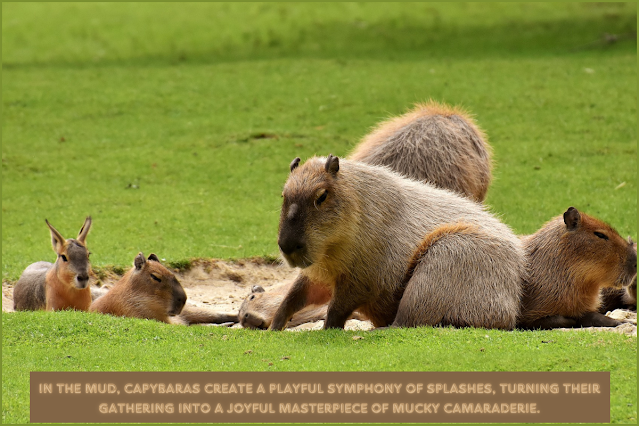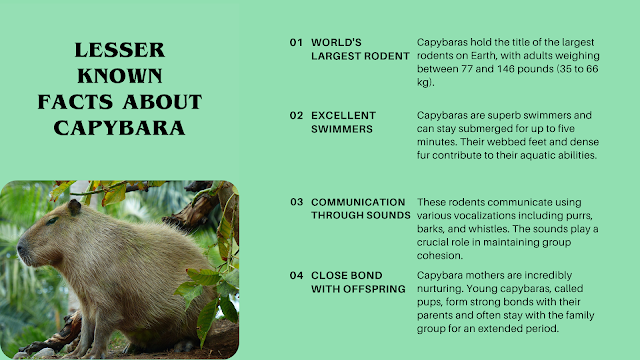Introduction:
In the heart of South America's diverse ecosystems, a unique creature roams the grassy plains and marshy wetlands – the capybara. As the largest rodent on Earth, these gentle giants, scientifically known as Hydrochoerus hydrochaeris, captivate the imagination with their social behaviors, aquatic prowess, and undeniable charm. This article embarks on a journey to explore the world of capybaras, shedding light on their physical features, social dynamics, and their integral role in the delicate balance of their ecosystems.
The Capybara Species:
The term "capybara" typically refers to the Hydrochoerus hydrochaeris, which is the largest living rodent in the world. Capybaras are native to South America and are found in a variety of habitats such as forests, grasslands, and near bodies of water. They are semi-aquatic and are excellent swimmers.
Physical Features and Size:
The physical allure of capybaras lies in their robust bodies, short legs, and a distinctive barrel-shaped appearance. Their dense, coarse fur, ranging in color from brown to reddish-brown, not only offers protection but also contributes to their buoyancy in water. Towering over other rodents, capybaras can weigh over 100 pounds, showcasing their impressive size.
Adaptations for Aquatic Life:
Capybaras exhibit remarkable adaptations for a semi-aquatic lifestyle, distinguishing them within the rodent kingdom. Their distinctive webbed feet, reminiscent of amphibians, play a pivotal role in enhancing their agility in the water. This unique anatomical feature allows capybaras to be adept swimmers, effortlessly navigating various aquatic environments, including rivers, lakes, and marshlands. Unlike typical rodents, capybaras showcase an exceptional ability to glide through water with ease. This aquatic prowess underscores their specialization for life near bodies of water, contributing to their status as the largest living rodent globally. Whether gracefully swimming in rivers or calmly traversing marshy landscapes, capybaras exemplify a harmonious blend of physical adaptations that make them truly exceptional in their semi-aquatic habitat.
Behavior and Social Structure:
The charm of capybaras lies in their profoundly social behavior, setting them apart as highly gregarious creatures. These rodents thrive in close-knit groups, creating cohesive units that serve as a robust defense mechanism against potential predators. Communication within these capybara communities is multifaceted, involving an array of vocalizations including distinctive barks, whistles, and purrs. Additionally, social bonds are reinforced through grooming rituals and physical contact, further solidifying the intricate network of relationships within the group. The captivating social dynamics of capybaras not only contribute to their overall charm but also highlight their evolved capacity for cooperative living, a fascinating aspect that resonates with both wildlife enthusiasts and those seeking insight into the intricacies of animal behavior.
In observing capybaras, one is drawn to their unique social structure and the various ways they engage with one another, providing an enriching experience for those interested in the fascinating world of wildlife behavior.
Diet and Feeding Habits:
Capybaras are herbivores with a preference for grasses and aquatic vegetation. Their grazing habits play a crucial role in shaping the landscapes they inhabit. As constant grazers, capybaras contribute to the maintenance of grassy plains and marshy ecosystems, creating a harmonious balance with their surroundings.
Reproduction and Family Life:
Capybaras' reproduction and family life unfold in tightly bonded units, adding a captivating dimension to their natural history. Mating rituals are marked by expressive vocalizations and mutual grooming, fostering a strong connection that culminates in the birth of precocial offspring. Capybara mothers exhibit remarkable nurturing behaviors, creating a supportive environment for their young, known as pups. These little ones swiftly assimilate into the intricacies of group dynamics, seamlessly becoming integral members of the capybara family. The harmonious interplay between mating rituals, maternal care, and the integration of offspring paints a vivid picture of the rich family life that characterizes capybara communities, making them a compelling subject for those intrigued by the wonders of wildlife and animal behavior.
Habitat and Geographic Distribution:
Capybaras are adaptable creatures, inhabiting a range of ecosystems across South America. From the grassy plains of the Llanos to the dense Amazon rainforests, their geographic distribution spans countries like Brazil, Venezuela, and Colombia. They display a remarkable ability to thrive in diverse landscapes.
Distinctions between Capybaras and Rats:
Capybaras and rats belong to the same order, Rodentia, but they are part of different families. Capybaras are in the family Hydrochoeridae, while rats, such as common brown rats or Norway rats, belong to the family Muridae.
Despite their shared classification as rodents, capybaras and rats are quite distinct in terms of size, behavior, and habitat. Capybaras are the largest rodents, known for their semi-aquatic lifestyle, social nature, and herbivorous diet. They are native to South America and are often found near bodies of water.
On the other hand, rats are generally much smaller, have different behaviors, and are more adaptable to various environments. Rats are known for their ability to thrive in urban settings, often coexisting with humans.
In summary, while capybaras and rats are both rodents, they differ significantly in terms of size, behavior, and habitat preferences.
Conclusion:
Read More Article Like This:
Here are some questions and answers about capybara:


